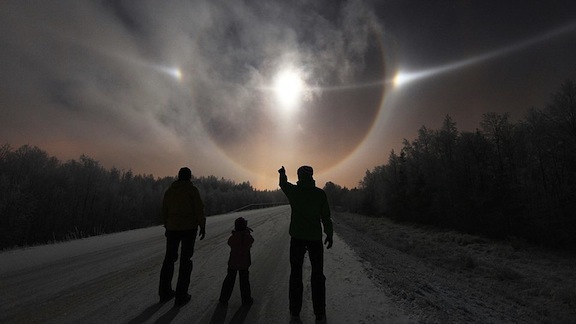Whoa. What Is That?
Classical Mechanics
Level
3

The pattern in the sky in the picture above is:
Image credit: Pauli Hänninen
none of the rest
a trick of a camera lens
the flight path of a super sonic jet
a rainbow
This section requires Javascript.
You are seeing this because something didn't load right. We suggest you, (a) try
refreshing the page, (b) enabling javascript if it is disabled on your browser and,
finally, (c)
loading the
non-javascript version of this page
. We're sorry about the hassle.
It's none of the above. In particular, it's not a rainbow.
Rainbows are caused by the refraction and reflection of sunlight by water droplets in the air (hence their name). If you think about it though, there’s obviously another way water can be suspended in the sky: as tiny ice crystals on a cold day. The ice version of the rainbow is the ice halo, formed when small hexagonal ice crystals are suspended in the sky and the sun (or moon on bright nights) is behind them. The ice crystals act like prisms and the sunlight forms a halo, which, as seen in the photo above, can be truly spectacular. Needless to say, this only occurs when the temperature is very cold and hence ice halos are most common in the colder regions of the earth.
Both rainbows and ice halos are full circles. However, for a rainbow you can only see the top half of the circle due to the horizon, while for a halo you can usually see the whole circle. An ice halo is a smaller circle as the halo is formed by refraction (the bending of light) alone as it passes through the ice crystals. You can see the same effect if you look at a coin in a swimming pool - the coin appears to be in a different spot because the light from the coin refracts as it passes from water to air. A rainbow, on the other hand, requires reflection off the inside of the water droplets as well as refraction as the light enters and leaves the water droplets. This combination of processes makes for a much bigger circle. You can figure out that reflection is needed by the fact that you face away from the sun to see a rainbow, i.e. the light is reflecting off the water droplets in the air. Ice halos are visible as you face the sun since only refraction is involved.
If the ice crystals that are responsible for the halo are completely randomly oriented, then the halo is a perfect circle of equal intensity all around. This is an example of symmetry. The line between the sun and you establishes an axis, but if the ice crystal orientations are random then there is no other way to establish another direction and hence there is a residual “rotational symmetry” - the halo intensity is the same around the circle. However, in many cases there are two bright spots, called "sun dogs", that are on a horizontal line even with the sun. Sun dogs occur because the orientation of the ice crystals are not random. As the crystals fall to the ground, the airflow around them tends to orient the crystals horizontally, which creates the sun dogs.